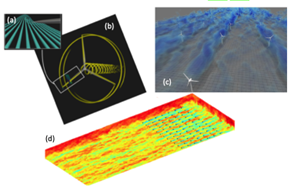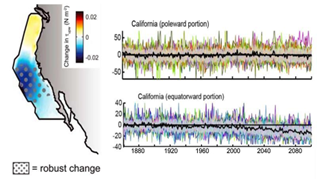Metocean Theme
Jiwen Fan, Lead, and Katherine Smith, Co-Lead
Goal: Determine how the wind resource and metocean environment, including the impact of extreme events, will change on time scales ranging from weeks to decades.
Meteorological and oceanic (metocean) conditions have significant, yet constantly changing effects on the availability of the offshore wind resource and the wind turbine’s environment. A combination of measurements and simulations will allow the team to estimate the wind resource in areas of potential floating offshore wind deployment. This theme also focuses on understanding how wakes from wind farms interact with metocean conditions and how metocean conditions will change in future climates across time and space.
Wind Farm Wakes and Wind Plant Inflow
Offshore wind farms directly interact with and alter the surrounding oceanic and atmospheric conditions by affecting waves and wind flows. Representing these processes in their full complexity is extremely challenging because they must be modeled in concert with the surrounding natural environment. This work seeks to create and test representations of how different floating offshore wind farms affect metocean conditions for use with the Department of Energy’s Exascale Energy Earth System Model (E3SM) for the first time. The developed parameterizations can then be applied to other Earth system models.

Impact of Large-Scale Processes on Levelized Cost of Energy
Large-scale climate patterns and processes can affect the hub-height wind, temperature, and wind shear over the rotor diameter. These processes are dynamic and include extreme events with ever-changing frequencies. This work focuses on understanding and modeling how the large-scale climate will affect offshore wind regimes and wind farm operations under both the current and future climate. Simply modeling the current climate is insufficient to understand the long-term variability of specific locations for energy generation.

Impact of Regional Coastal Processes on Levelized Cost of Energy
Regional coastal processes regulate metocean conditions and the wind resource at time scales of hours, days, and weeks. Large-scale processes provide the background metocean conditions, while variabilities at short time scales are determined by regional metocean systems. Coastal weather can change the wind resource. Research focusing on the U.S. West Coast seeks to understand how local conditions can alter the available wind energy as well as infrastructure costs. The approach will be twofold, looking at both common and extreme weather systems in our current and future climate. This work will also quantify the power produced across different weather scenarios, helping identify the impact of different weather on overall costs.
